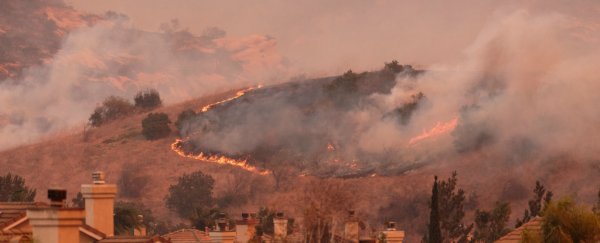Everyone knows the internet is a hotbed for ridiculous conspiracy theories. From chemtrails to Flat Earth, it seems like conspirators are always accusing the government of hiding something.
Now, a new and completely unsubstantiated theory is taking hold.
Far from being a result of wide-spread drought and climate change, online conspirators are claiming the California wildfires are also part of a secret government mission.
ODD T.V. is just one of the YouTube channels promoting this groundless theory, and – surprise! – it's run by a self-confessed Flat Earther.
In a video with nearly 200,000 views, this flat-earth YouTuber argues the recent California wildfires defy the laws of physics and are "very strange and suspect to say the least."
In drone footage of the aftermath, the narrator reveals large swaths of land that appear selectively burned. In the footage, nearly all of the houses are burned to the ground, while the surrounding landscape and foliage appears untouched by flame.
"We have specific areas being burned like energy was being directed at certain things," the narrator says.
"You gotta ask yourself, 'What's up with that?'"
Looking at these photos, conspirators find it all too easy to make the massive causal jump from wildfires to government-controlled Direct Energy Weapons (DEW) – think of a big laser that can focus energy on a specific target. Of course, how logical!
But the reality is, while several countries and companies are working on the prototypes of such weapons, there isn't enough evidence to suggest such a weapon is currently being used in the field.
Nevertheless, online conspirators like ODD T.V. firmly believe the recent wildfires defy the laws of physics, and they see DEW as a perfectly sound explanation.
We won't bother debunking that particular absurd theory - but why were the houses burnt and not the surrounding foliage in those photos? We turned to science for answers.
The irony of the wooden house
There's a logical explanation for the strange pattern of burning, according to David Peterson, a senior research biologist at the USDA Forest Service Pacific Northwest Research Station.
In order to start a fire you need three ingredients: fuel that is dry enough to burn, weather that is warm, dry and windy, and - of course - an ignition source.
We normally think of logs, twigs, leaves and shrubs as fuel, but Peterson says in wildfires, houses can also be fuel.
In fact, in a lot of ways, houses are a better source of fuel than the greenery surrounding them.
"Trees are full of water, so they're wet," Peterson told Science AF.
"And that's why a lot of them won't burn - because they have too high of a heat capacity stored in the water to actually combust. Although if you look closely at those photos you can see there's a lot of vegetation that still burned."
Contrary to conventional wisdom, Peterson explained, wood houses don't actually burn more than their steel counterparts. If it gets hot enough, a building with a steel frame is far more likely to melt and crumple than one made with big wooden beams. And nowadays, a lot of houses in California are made with steel.
"Big logs and big trees out in the woods and so forth typically don't burn except right around the outside," he told us.
"You need a tremendous amount of heat over a long time to burn right through a log. If you had a house made of huge wooden beams, it would probably stay standing after the fire."
Plus, there's also some randomness involved. Peterson explained that when embers are flying all over the place - thanks to erratic winds - it's much more likely they hit the roof of a house and ignite that than blow through the branches of a tree.
"You have some houses that are more combustible than others because of how they were built, and there's also some element of luck and randomness to that," he said.
"So all of that creates kind of a chaotic situation."
He agrees the pattern of burning is worrisome - but for a very different reason.
"The kinds of photos that we saw from Santa Rosa and other places were quite anomalous in that almost every single house burned down," he told Science AF over the phone.
"It tells you something about the intensity of the heat. The energy released from those fires was quite extraordinary in my experience, and I've been looking at this stuff for almost 40 years."
Peterson said it's something people need to be paying attention to, now that experts have predicted these wildfires will become far more regular.
"The type of fires we've seen there and the type of fires we are seeing in southern California this week are essentially not preventable. So it's a matter of how are we going to respond in areas that are now going to burn once every couple of years."
